Definition of Cultural Diversity
- Diversity – “the inclusion of different types of people (such as people of different races or cultures) in a group or organization” (Diversity, n.d., para. 2).
- Cultural Diversity – co-existence of different behavior, traditions, beliefs, and values in the settings of a community (UNESCO, n.d.).
Cultural diversity in the workplace has become a central question for HR specialists in recent years due to the increase of globalization in the world.
Before introducing the training series that would help employees to recognize the impact of diversity in the workplace, it is crucial to define diversity. The two definitions given on this slide can both be used to address the matter; however, it would be more beneficial to use the definition of cultural diversity by UNESCO (n.d.). It should also be stated that recent research also includes the presence of different sexual orientations in a group of people into the definition (Martin, 2014).
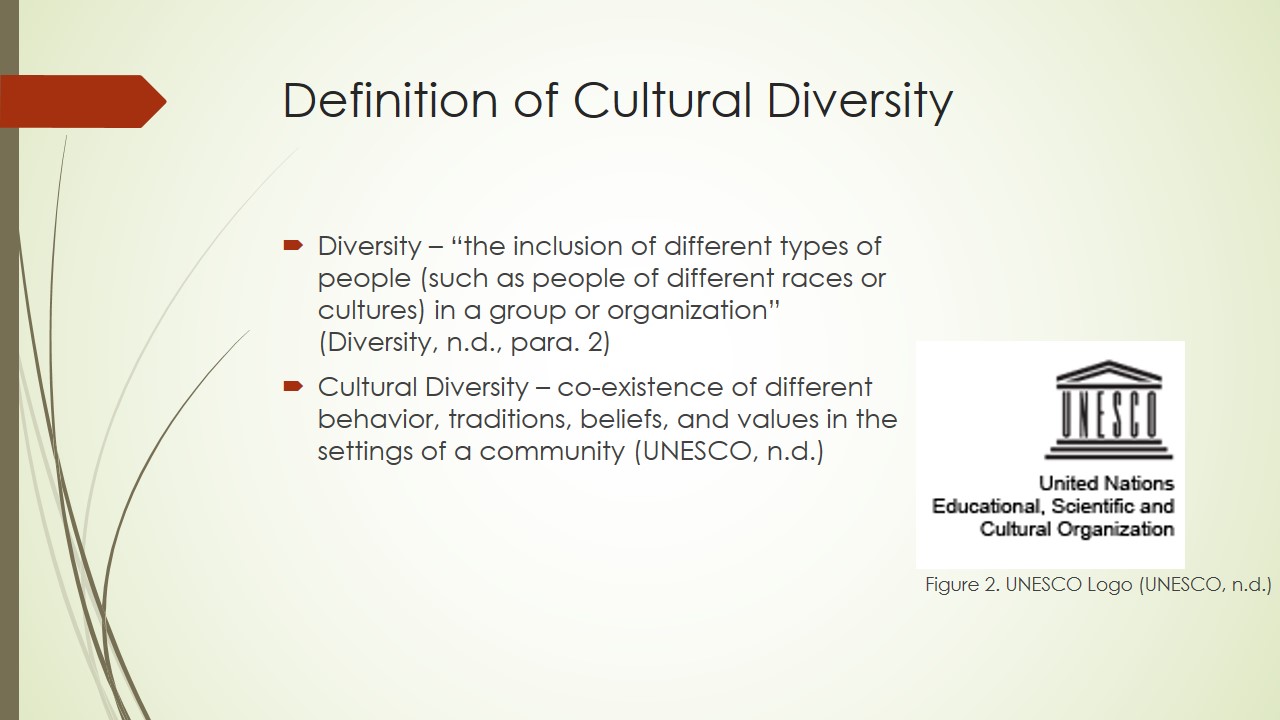
Effects of Cultural Diversity in the Workplace
- Adverse effects according to Martin (2014):
- A difference in opinions may lead to an increased count of interpersonal conflict;
- Contrasting views on matters can hinder the development of unity.
- Benefits according to Martin (2014):
- Different ways of thinking help to analyze a matter from a variety of perspectives;
- Acquaintance with various traditions helps to overcome cultural shock if the business expands in other countries;
- Culturally diverse workers can become experts in a foreign country and consult concerned employees.
The effects of diversity in the workplace given on this slide help to realize the importance of the matter. The training series offered in the presentation will assist in overcoming the negative side of the cultural differences and increase all the positive effects.
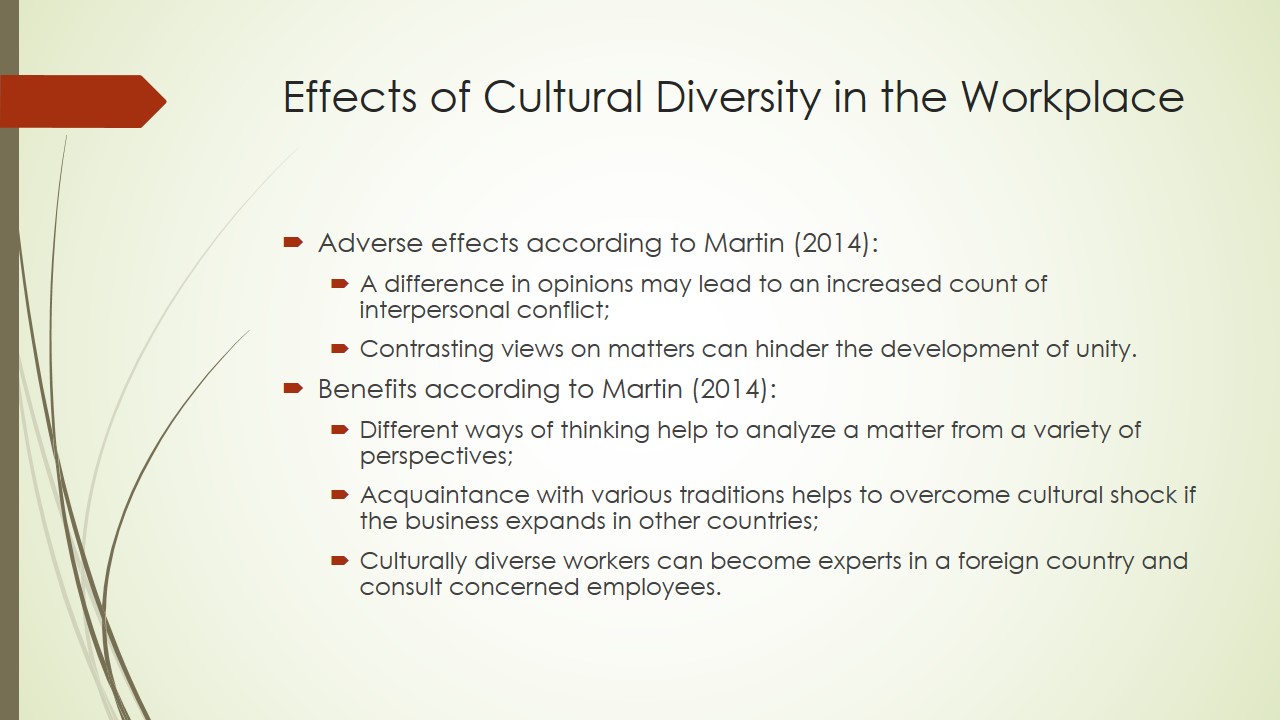
Expected Outcomes
- Increased appreciation of the different perspectives induced by cultural diversity.
- Further development of the sense of corporate unity.
- Decreased number of conflicts in the workplace.
- Facilitation of expanding the business in foreign countries.
The expected outcomes listed on this slide are closely connected to the effects of diversity in the workplace discussed previously. It is also worth mentioning that according to Lambert (2016), appreciation of cultural differences can become a driving force for innovation and creativity. Therefore, one of the outcomes that may be expected is a gradual shift in the corporate trend from perceived security to innovation. The matter was not included in the slide because it is not an objective of the training series.
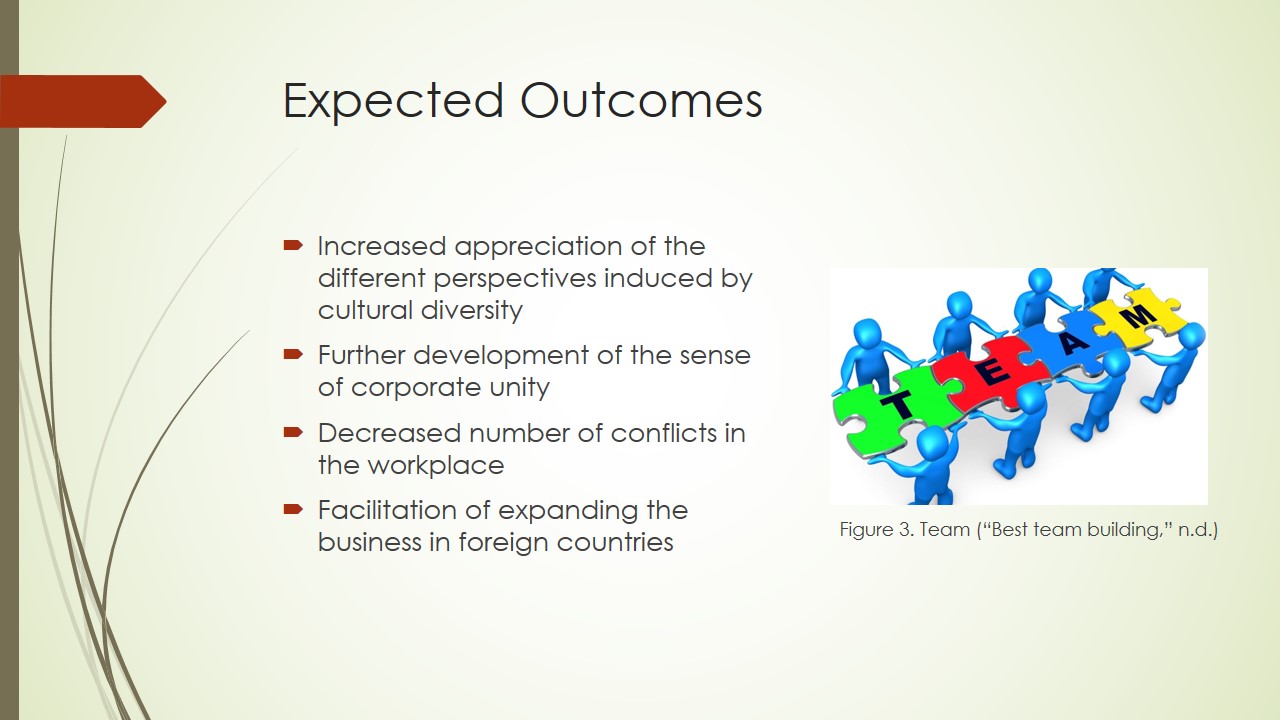
Strategy
- Diversity perspective can be more explicit through the behavior of leaders and learning rather than through formal policies (Lambert, 2016)
- The proposed plan aims at modeling behavior of the employees through:
- Lectures;
- Movie discussions;
- Inter-personal activities.
- The plan is developed for 4 weeks, 3-4 hours a week.
Recent studies show that integration and learning is a more effective tool for achieving the inclusion of minorities in the workplace (Lambert, 2016). Therefore, rather than creating formal policies, the present project aims at modeling the behavior of the employees through educational activities. The workers will be offered 1.5-hour classes two times a week, during which they will acquire knowledge about the effects of cultural diversity and develop skills to overcome the subconscious bias. While it would be more beneficial to have longer sessions, the plan takes into consideration the busy schedule of the employees. The training sessions will take place after the regular working hours.
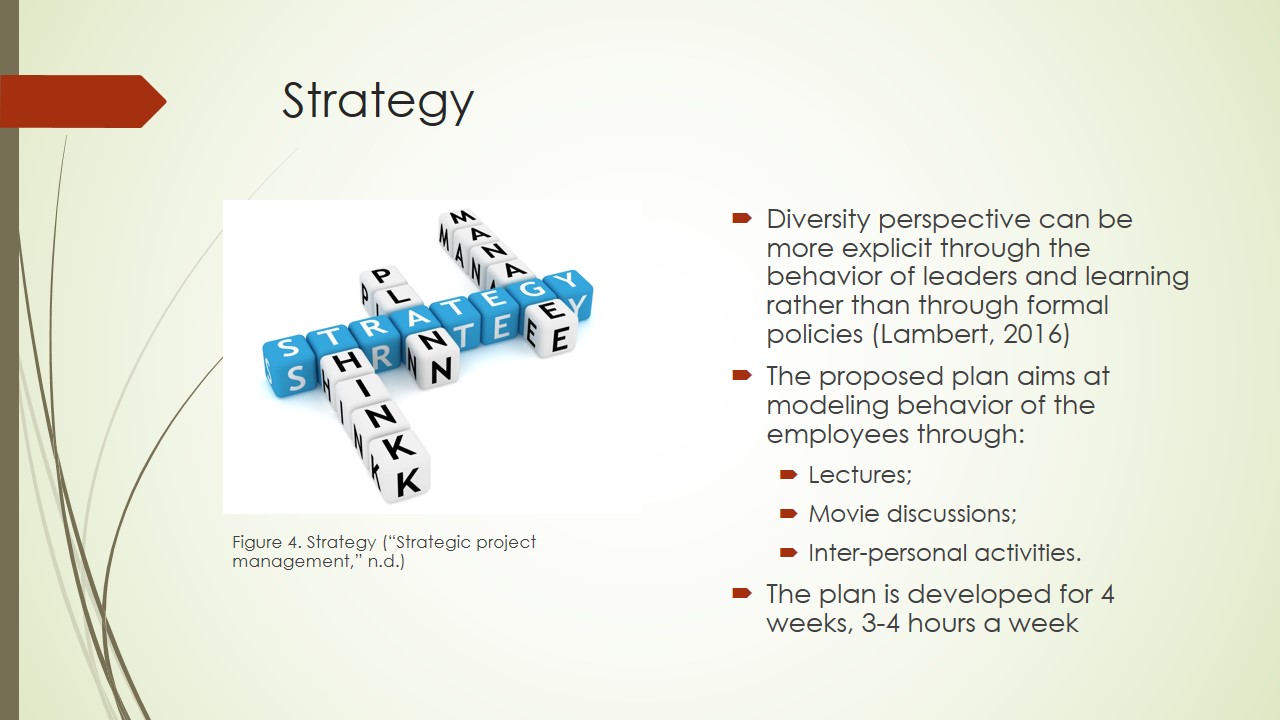
Issues Covered
- The training series covers cultural issues studied by Hofstede (2009):
- Power distance;
- Individualism;
- Masculinity;
- Uncertainty avoidance;
- Long-term orientation.
- Additionally, activities will help to overcome bias due to:
- Sexual orientation;
- Religion;
- Political views.
- The effects of cultural diversity at the workplace will also be in focus.
By the end of the intervention, employees will acknowledge both broad and narrow differences in culture. The training series will provide an in-depth analysis of moral norms and values rooted in the history of minority groups that will support inclusion in the community. The minority group members will be offered to make a presentation of what they think is important to know about their culture and the insights will be compared to the information provided by the trainer and discussed.
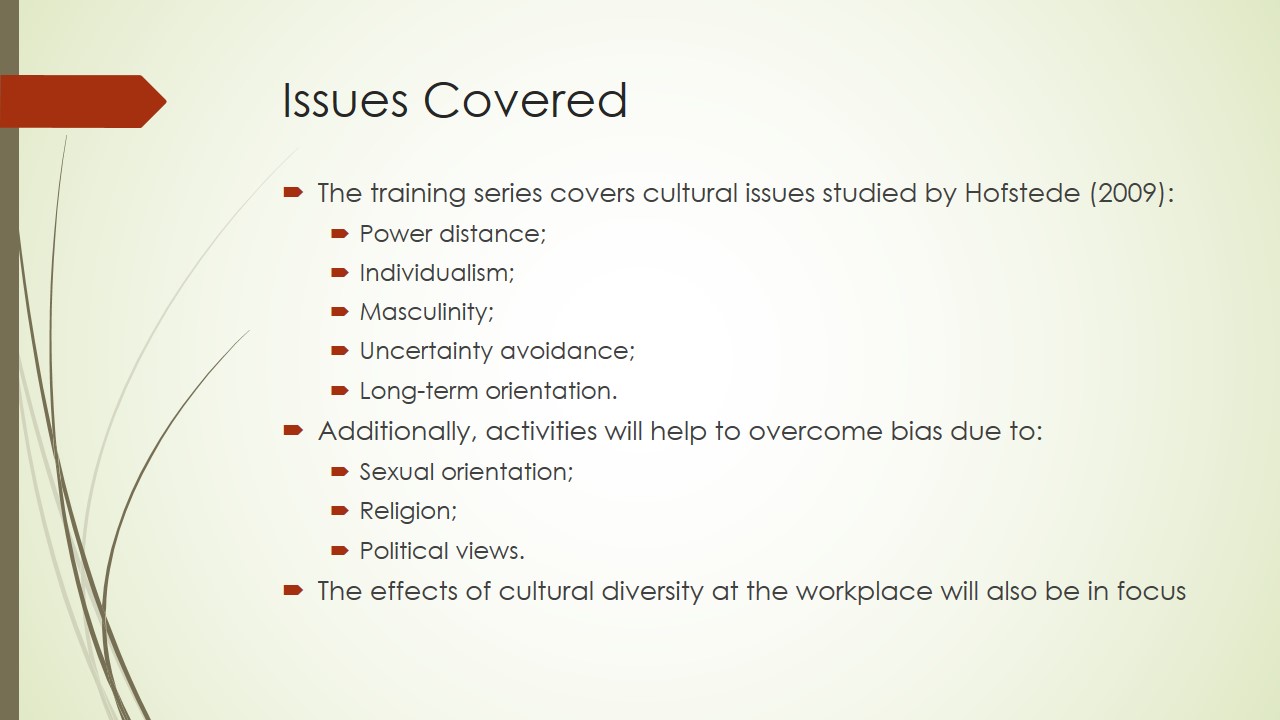
Action Plan
- Session 1. Introduction to the course. Getting to know each other:
- A short lecture on the definition of diversity and training objectives;
- Introduction games.
- Session 2. Effects of diversity in the workplace:
- Lecture on the topic;
- Discussion of the movie Life of Pi.
- Session 3. Religious differences:
- Lecture on the history of Christianity, Islam, and Hindu;
- Discussion of parallel motives in different beliefs.
- Session 4. Sexual orientation:
- Lecture and discussion questions;
- Session 5. Politics:
- A brief history of the forms of government;
- Discussion of the pros and cons of the different political structures.
- Session 6. Hofstede’s cultural dimensions (part 1):
- A lecture and discussions of power distance, individualism, and masculinity.
- Session 7. Hofstede’s cultural dimensions (part 2):
- A debate about uncertainty avoidance and long-term orientation;
- The drawbacks of applying the Hofstede’s model.
- Session 8. Concluding statements. Reflections on the training series.
It is worth mentioning that the movie directed by Lee (2012) Life of Pi was chosen for two reasons. First, it provides a vivid example of how cultural diversity can help a man to survive in unusual circumstances. The main character of the movie can be associated with an enterprise and comparison can help to draw conclusions on the matter. Second, the film is an excellent example of religious tolerance, as Pi Patel practiced three religions at the same without internal contradictions. The movie helps to realize that while there may be certain cultural differences, all people share a common goal.
During the last meeting, all the trainees will be asked to provide feedback about the seminars to the group orally. They will be encouraged to tell everyone about what they have learned and how the insights will influence their future behavior. Moreover, every employee will be free to evaluate if the intervention was a success and give advice on how it should be changed.
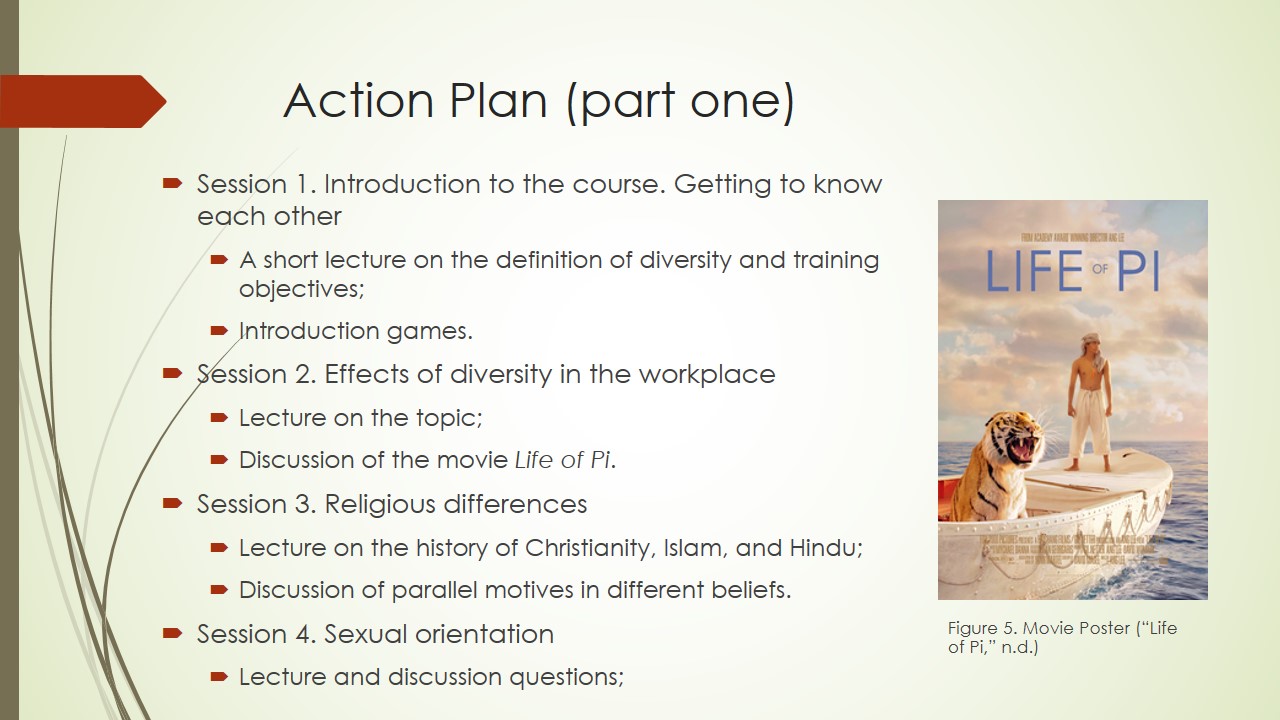
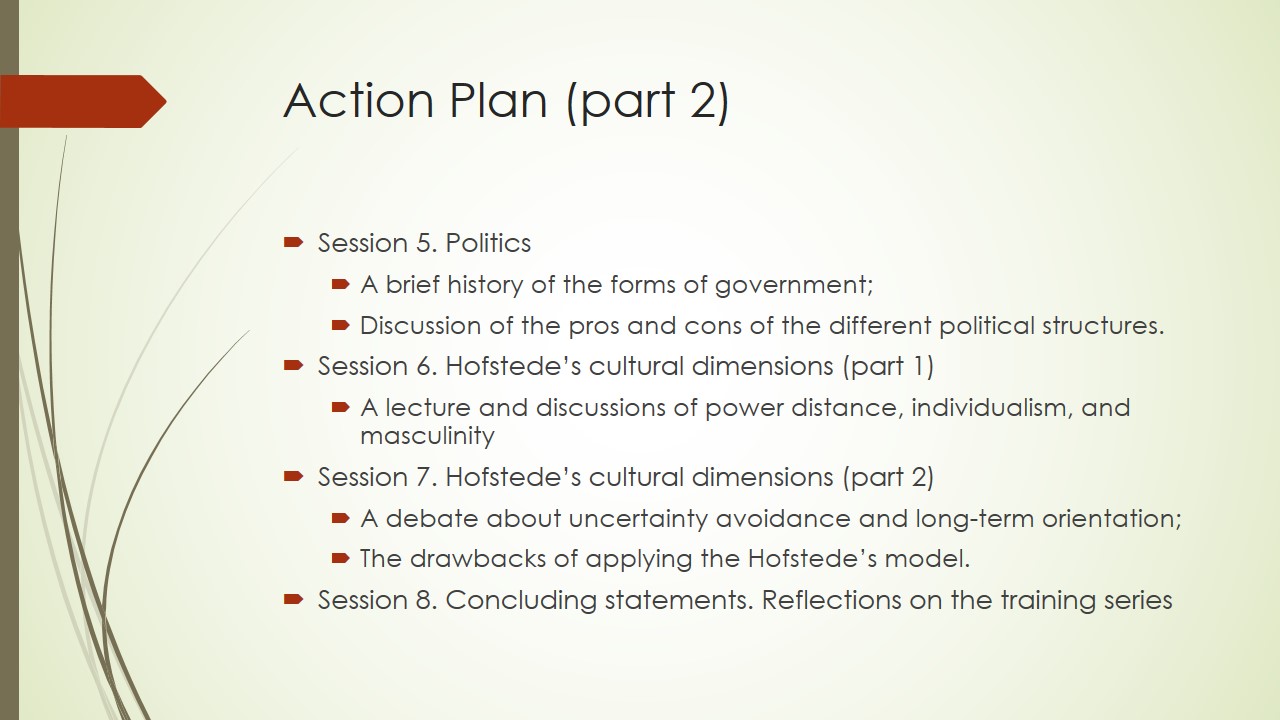
Conclusion
- The central goal of the program is to encourage the inclusion of minorities into community development.
- The strategy includes providing education rather than forcing formal policies.
- The issues covered range from apparent cultural differences to subtle controversies induced by diversity.
- The time needed for the intervention is about a month.
- The expected results include enhanced communication among minority groups and a decrease in inter-personal conflicts.
The project can be easily implemented, as it does not require considerable financial investments or help from outside parties. The timeframe was designed to fit the schedule of the majority of organizations, as it takes into consideration the standard timetable of employees. If an organization does not have a designated trainer for the proposed intervention, the budget would include only the spending on hiring a specialist in the matter.
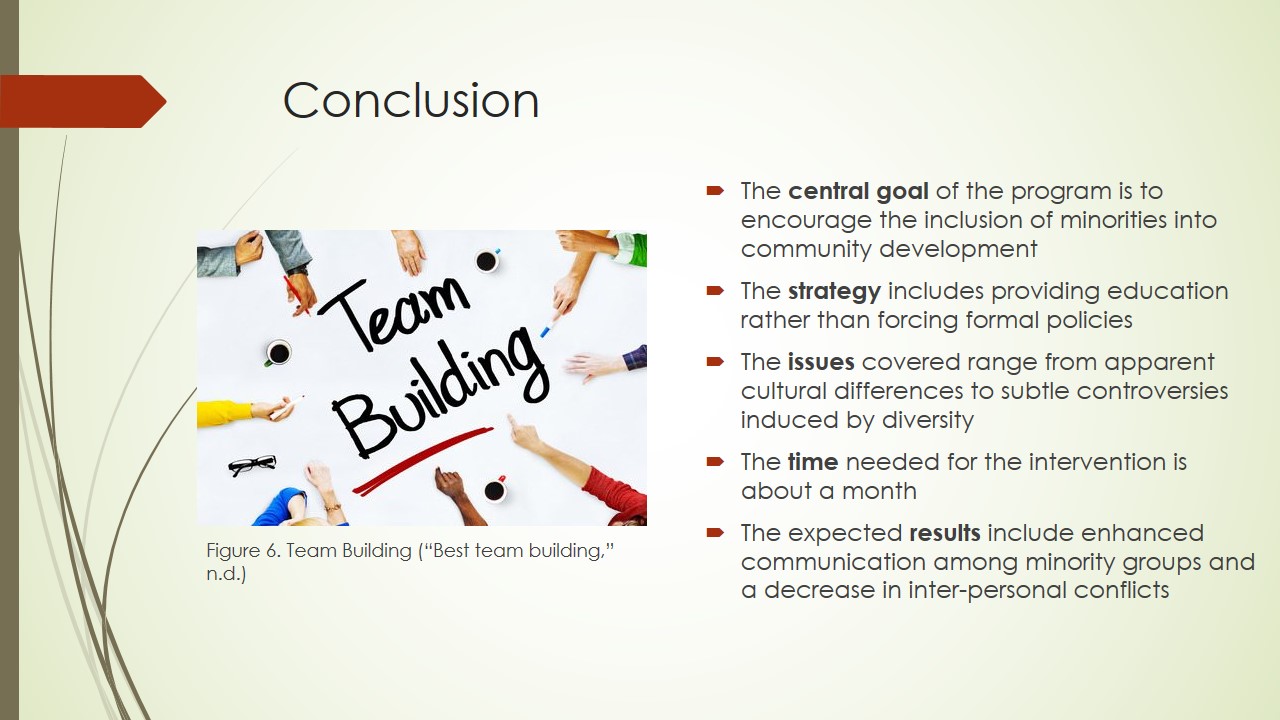
References
Best team building activities in Atlanta. (n.d.). Web.
Colletta, J. (2018). Spotify ‘gets real’ about improving workplace diversity. Web.
Diversity. (n.d.). In Merriam-Webster’s online dictionary (11th ed.). Web.
Hofstede, G. (2009). Geert Hofstede cultural dimensions. Web.
Lambert, J. (2016). Cultural diversity as a mechanism for innovation: Workplace diversity and the absorptive capacity framework. Journal of Organizational Culture, Communications and Conflict, 20(1), 68-77.
Lee, A. (Producer), & Netter, G. (Director). (2012). Life of Pi [Motion Picture]. USA: 20th Century Fox.
Martin, G. (2014). The effects of cultural diversity in the workplace. Journal of Diversity Management (JDM), 9(2), 89-92. Web.
Strategic project management: 7 ways to boost the bottom line. (n.d.) Web.
UNESCO. (n.d.). Cultural diversity. Web.